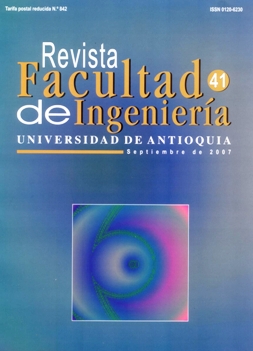Husk of rice as source of SiO2
DOI:
https://doi.org/10.17533/udea.redin.19012Keywords:
Husk of rice, silica, synthesis, characterizationAbstract
The husk of rice contains high levels of silica when calcined. This work was carried out to study the nature of the organic components where the silicon complexes are nucleated and the best conditions for the synthesis of SiO2. The husk of rice and silica were analized by SEM, DRX, FTIR, TGA. The husk was treated with HCl to eliminate impurities as Fe, Na, K, etc. The results show that silica nucleates in the external part of the husk, composite of cellulose. SiO2 is amorphous, with a high specific surface (~2772 m2 /g), arbitrary morphology and nanometric size (< 200 nm).
Downloads
References
E. J. Baran. Química Bioinorgánica. Madrid McGraw-Hill / Interamericana de España, S. A. 1995. pp. 197-205.
R. K Iler. The Chemistry of Silica. New York. John Wiley & Sons, Inc.1979. pp. 740-747.
J. I. Martín. The desilification of rice hulls and a study of the products obtained. MS Thesis. Lousiana State University. 1938. pp. 10-21, 52-57.
H. Ishibashi. “Properties of SiO2 from rice hulls”. J. Sci. Sol Manure. Vol. 10. 1936. pp. 244-249.
M. Oota. “The biological action of submicron amorphous silicate”. Bull. Fac. Lib. Arts Educ. Yamushi Uni. Vol. 5. 1954. pp. 183-187.
R. V. Krishnarao, J. Subrahmanyam, T. Jagadish Kumar. “Studies on the formation of black particles in rice husk si-lica ash”. J. Eur. Ceram. Soc. Vol. 21. 2001. pp. 99-104. DOI: https://doi.org/10.1016/S0955-2219(00)00170-9
F. C. Lanning. “Silicon in Rice”. J. Agric. Food. Chem. Vol. 11. 1963. pp. 435-437. DOI: https://doi.org/10.1021/jf60129a024
A. Chakraverty, P Mishra, H. D. Bnerjee. “Investigation of combustion of raw and acid-leached rice husk for production of pure amorphous white silica”. J. Mater. Sci. Vol. 23. 1988. pp. 21-24. DOI: https://doi.org/10.1007/BF01174029
A. Swineford, P. C. Franks. “Nature of silica deposito in plants” Soc. Econ. Paleontologist Mineralogists Spec. Publ. Vol. 7. 1959. pp. 11-20.
K. E. Kurtis, F. A. Rodrigues. “Early age hydration of rice hull ash cement examined by transmission soft X – ray microscopy”. Cement and Concrete Res. Vol. 33. 2003. pp. 509-515. DOI: https://doi.org/10.1016/S0008-8846(02)00995-X
R. V. Krishnarao, M. M. Godkhindi, M. Chakraborty, P. G. Mukunda. “Direct pyrolysis of raw rice husks for maximization of SiC whisker formation”. J. Am. Ceram. Soc. Vol. 74. 1991. pp. 2869-2875. DOI: https://doi.org/10.1111/j.1151-2916.1991.tb06856.x
R. V. Krishnarao, Y. R. Mahajan, T. J. Kumar. “Conversion of raw rice husks to SiC by pyrolysis in nitrogen atmosphere”. J. Eur. Ceram. Soc. Vol. 18. 1998. pp. 147-152. DOI: https://doi.org/10.1016/S0955-2219(97)00093-9
S. B. Hanna, N. A. L. Mansour, A. S. Taha, H. M. A. Abd-allah. “Silicon carbide and silicon nitride from rice hulls-III-Formation of Silicon nitride”. Br. Ceram. Trans. J. Vol. 84. 1985. pp. 18-21.
A. Karera, S. Nargis, S. Patel, M.Patel. “Silicon based materials from rice husk”. J. Sci. Ind. Res. Vol. 45. 1986. pp. 441-448.
J. A.l Amick. “Purification of rice hulls as a source of solar grade silicon for solar cells”. En: J. Electrochem. Soc.: Solidstate Science and Technology. Vol. 129. 1982. pp. 864-866. DOI: https://doi.org/10.1149/1.2123989
D. S. Chaudhary, M. C. Jollands. “Characterization of rice hull”. J. App. Polym. Sci. Vol. 93. 2004. pp. 1- 8. DOI: https://doi.org/10.1002/app.20217
G. Sócrates. Infrared Characteristic Group Frequencies. John Wiley & Sons. New York. 1994. pp. 126-127.
B. T. Cardona. “Obtención de fases del cemento utilizando desechos agrícolas e industriales”. Ciencia UANL. Vol. 2. México. 2002. pp. 190-194.
Downloads
Published
How to Cite
Issue
Section
License
Revista Facultad de Ingeniería, Universidad de Antioquia is licensed under the Creative Commons Attribution BY-NC-SA 4.0 license. https://creativecommons.org/licenses/by-nc-sa/4.0/deed.en
You are free to:
Share — copy and redistribute the material in any medium or format
Adapt — remix, transform, and build upon the material
Under the following terms:
Attribution — You must give appropriate credit, provide a link to the license, and indicate if changes were made. You may do so in any reasonable manner, but not in any way that suggests the licensor endorses you or your use.
NonCommercial — You may not use the material for commercial purposes.
ShareAlike — If you remix, transform, or build upon the material, you must distribute your contributions under the same license as the original.
The material published in the journal can be distributed, copied and exhibited by third parties if the respective credits are given to the journal. No commercial benefit can be obtained and derivative works must be under the same license terms as the original work.










 Twitter
Twitter